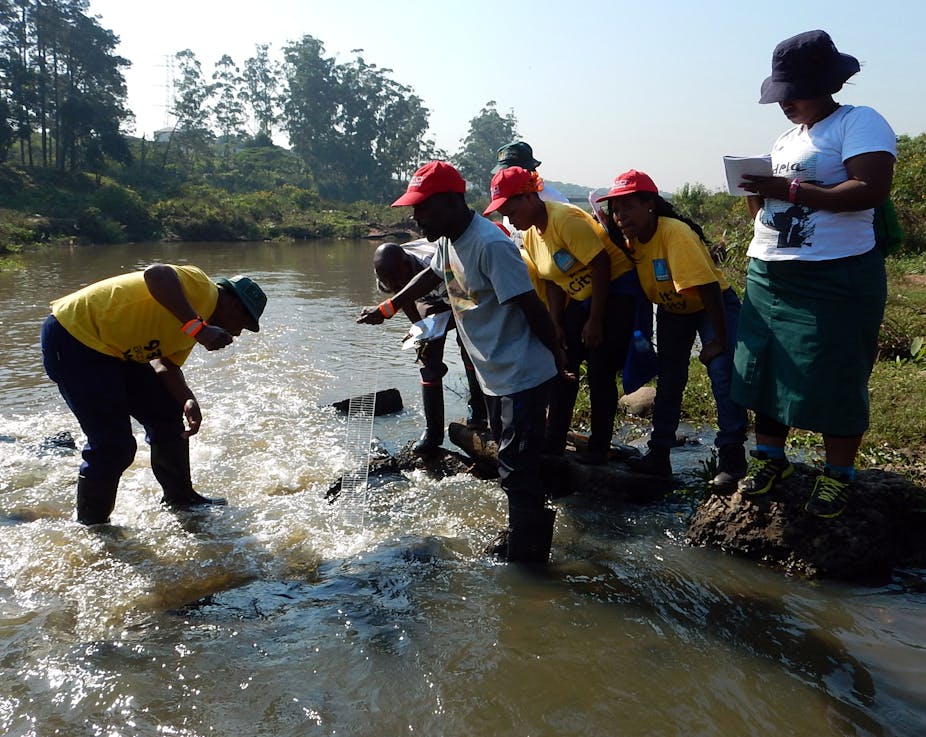Across South Africa, sewage systems are leaking and contaminating the country’s freshwater. Involving the affected communities can help prevent this pollution hazard, as a group of 15 citizen scientists in KwaZulu-Natal province have shown. Their community water monitoring programme, working with municipal authorities, has managed to prevent raw sewage from flooding into rivers.
The young, unemployed residents from Mpophomeni, a working-class area, became “Enviro-Champs” in 2009 through a partnership initiated by the non-profit Duzi uMngeni Conservation Trust and the Mgungundlovu District Municipality. By 2021, similar intiatives had started up in other parts of South Africa.

Working together with community members, we carried out research to scientifically approach the ongoing work and concept of the Enviro-Champs. We found they could use a customised app on their smartphones to report data about environmental hazards, such as sewage spills, to their managers in real time. This would then be reported to local authorities.
Freshwater is growing scarcer and more polluted in South Africa. Our research with the Enviro-Champs demonstrated that there was potential for citizen scientists using apps to do similar work across rural South Africa. Community awareness and mobilisation is needed if freshwater is to be better monitored and managed.
The problem
The quality of South Africa’s freshwater has deteriorated, becoming increasingly obvious in the last decade. This is because of poorly treated or untreated wastewater or sewage that flows into dams and rivers. The Department of Water and Sanitation’s annual Green Drop reports document this serious situation, showing last year that 576 sewage works, or 66% of the 876 that were assessed, were failing and at risk of becoming completely dysfunctional.
Contaminated freshwater leads to tragedies such as the cholera outbreak in South Africa’s Hammanskraal region in 2023, when at least 40 people died from contaminated water sources. Cholera is associated with contaminated food and water and usually relates to poor water, sanitation and hygiene practices.
Read more: Cholera in South Africa: a symptom of two decades of continued sewage pollution and neglect
South Africa’s freshwater is also polluted by nutrient loading. This is where water and waste rich in nutrients ends up in rivers, streams and dams. Nutrient pollution comes mainly from poorly functioning sewage treatment works, runoff from fertilised farm land, and waste from cattle feedlots and chicken houses. When it runs into rivers and dams, it can lead to the growth of toxic blue-green algae blooms (cyanobacteria). This can cause tumours and cancer. Cyanobacteria have degraded the Hartebeestpoort dam (in South Africa’s North West province) to the level that its water is largely unsafe for recreational use or even animal consumption.
In KwaZulu-Natal, the uMsunduzi River which flows through Pietermaritzburg shows increasingly high Escherichia coli (E. coli) counts, a sign of severe sewage pollution. E.coli can cause cramps, severe diarrhoea and even kidney failure. It is safe to predict that over time, South Africa will suffer large-scale ecological, financial and human disasters if the freshwater crisis is not solved urgently.
Citizen scientists to the rescue
The Enviro-Champs citizen scientists joined a Duzi-uMngeni Conservation Trust project that was set up to respond to the problem of raw sewage that flowed from 104 leaking manholes in Mpophomeni into streams and then into the nearby Midmar Dam. This dam is the main water source for 4.3 million people in the cities of Pietermaritzburg and South Africa’s third largest economic hub, Durban.

The Enviro-Champs became the eyes and ears of the community and were able to take action to solve problems. They checked water quality, reported issues and, at times, repaired freshwater leaks. They also monitored and removed litter and solid waste that had been dumped. The Enviro-Champs also became skilled at identifying and removing invasive alien plants.
They used citizen science tools such as clarity tubes to measure water clarity. The water clarity is then used to estimate the total suspended solid content of the water, a useful way to check the water quality.
Enviro-Champs also visited people at home in the community to share knowledge about waste, hygiene and sanitation issues. Their primary role was to let the local authorities know about sewage spills so that leaking pipes could be repaired before rivers were contaminated. Years of neglect in many parts of South Africa mean that these spills and leaks are largely ignored.
Through the network’s efforts, the 104 manholes that the Enviro-Champs had been monitoring stopped leaking sewage by 2016.
The solutions
The Enviro-Champs research found that they could send more comprehensive information to their managers if they had a customised mobile app to help capture data on sewage leaks and other issues. There are similar water quality monitoring apps in use globally. The best kind of app for the Enviro-Champs would be one with the capacity to upload photos, videos and GPS co-ordinates to a database. This information would also be shared with the group’s managers and potentially the local authorities in real time.

The app has now been developed and is in use, although there is little funding for maintenance, including upgrades and customisation, which costs a monthly fee. Mobile data is also a serious concern, especially in poorer rural areas where any extra expenses the Enviro-Champs incur can deter them from participating.
Through the efforts of the Duzi-uMngeni Conservation Trust, the South African National Biodiversity Institute, uMngeni-uThukela Water, Unicef-YOMA (the Youth Agency Marketplace), CGIAR, the International Water Management Institute and GroundTruth, the project has recently been upscaled. There are now 1,000 Enviro-Champs across KwaZulu-Natal, funded by the Presidential Employment Stimulus and Social Employment Fund.
Why it matters
Water contamination events that cause serious illness will become more common without drastic and urgent action to improve monitoring, conservation, treatment and management of South Africa’s freshwater resources. The story of the Enviro-Champs shows how communities practising citizen science can become better informed and lead important changes in society.
Nicholas B. Pattinson contributed to the research for this article.

